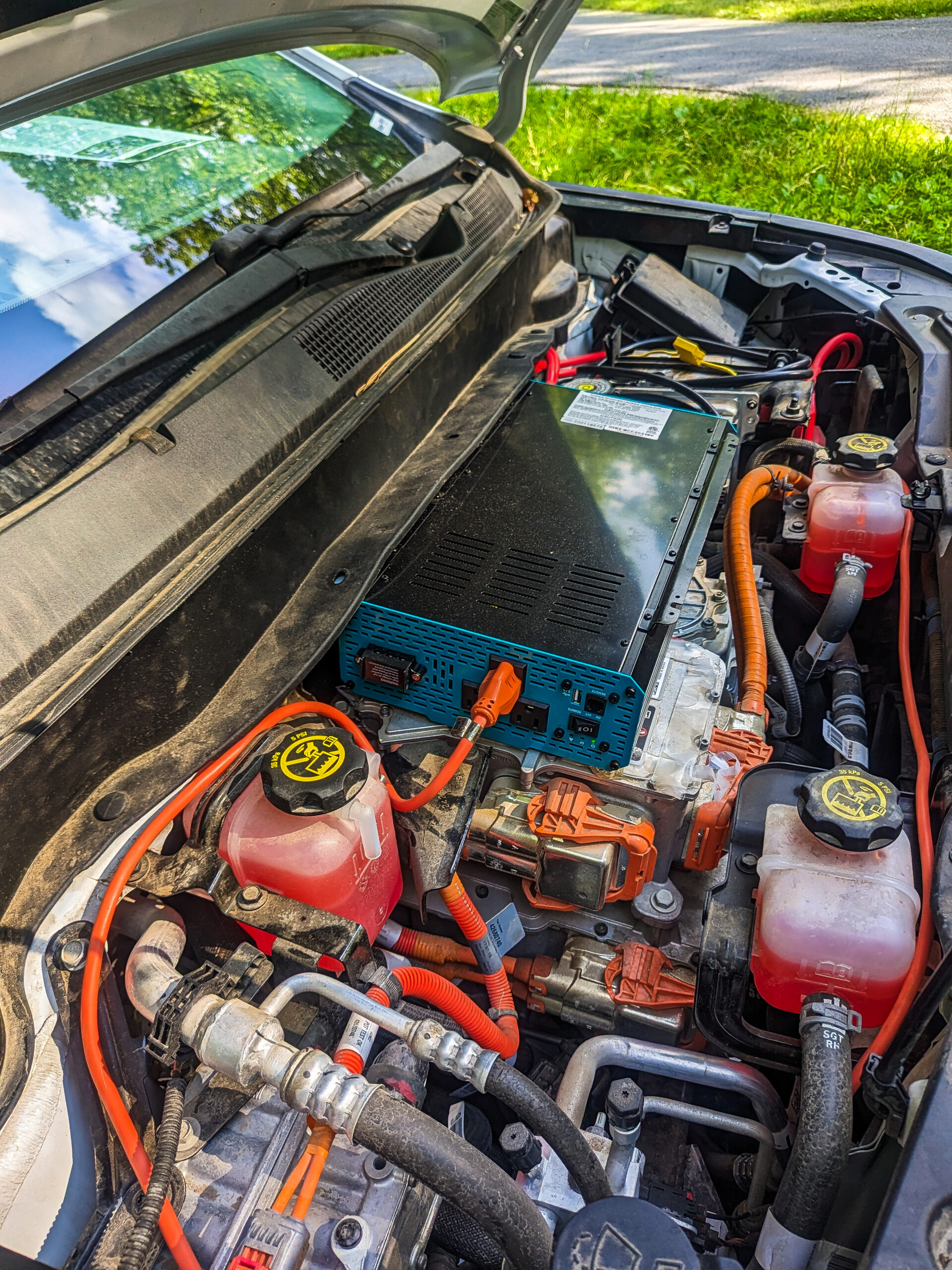Sign up for daily news updates from CleanTechnica on email. Or follow us on Google News!
The US Department of Energy is aiming to decarbonize millions of buildings with an assist from new electrochromatic window glazing, but there’s a hitch. The energy efficient glazing requires expensive new wiring to make it work. Or, does it? The California startup GuRu Wireless aims to apply its miniaturized, wireless energy transfer system to the electrochromatic field and they anticipate a 90% cost savings over conventional wiring.
Wireless Power For Energy Efficient Electrochromatic Windows
If GuRu can make electrochromatic windows go about their business without physical wiring, the company will make an impact on the energy efficiency field beyond a direct savings in costs and and carbon emissions. Eliminating miles of unnecessary wiring will have a ripple effect on supply chain carbon emissions and resource consumption, too.
GuRu has been deploying its wireless energy transfer technology on a demonstration basis in defense applications among other areas, and the US Department of Energy has spotted an opportunity to deploy the technology on windows, which are the notorious energy-wasting culprits of the built environment.
Back in July, Guru won a Small Business Innovation Research grant from the Energy Department’s Building Technologies Office under the the title, “Development of Wireless Power Technology for Use in Electrochromic Window Retrofit Applications.”
“GuRu Wireless Inc. intends to power electrochromic windows and their control systems wirelessly, using radio frequency wireless power transfer,” BTO explained in a press statement. “This proof-of-concept project aims to validate wireless power transfer as an option to avoid the expense of hardwiring.”
Why Is The Energy Department So Excited About Electrochromatic Windows?
For all the media attention lavished upon the latest development in the electric vehicle field, the somewhat less sexier field of window energy efficiency is just as vital to the global decarbonization effort.
Wireless or not, the Energy Department is targeting electrochromatic window technology as a key piece of the puzzle. Electrochromatic systems automatically tune the tint of window glass to prevent excess solar heat gain when the sun is shining, without interfering with the basic function of a window, which is to let daylight in and let people see out.
A simple electrochromatic retrofit for existing windows would have a huge impact. The Energy Department notes that buildings in the US waste more than $200 billion in energy costs every year, with windows taking much of the blame.
“In the United States, heat loss or gain through windows account for approximately four quads of combined heating and cooling energy use at an annual cost of more than $40 billion,” the Energy Department explained in a 2022 report on electrochromatic window technology, in which they calculated that an “aggressive” electrochromatic window deployment campaign would save almost 25% of that total, or $10 billion annually.
The Need For Wireless Electrochromatic Windows
In the same report, the Energy Department took note of significant follow-on savings from the use of electrochromatic window technology. “EC windows offer additional cost savings opportunities by enabling the downsizing of heating, ventilating, and air-conditioning (HVAC) systems,” the Energy Department observed. In addition to cost savings, the ripple effect of downsizing HVAC systems would also impact supply chain emissions and resource consumption
The problem, of course, is the up-front cost of electrochromatic technology. The Energy Department anticipates that costs would be partly offset by reducing the size and cost of HVAC systems. Still, they stressed the need for a more economical technology solution.
“If EC windows are widely adopted, residential and commercial building sectors could reach energy savings of 0.62 and 0.15 quads, respectively. However, meeting that level of adoption requires better cost and performance metrics than those currently achieved by commercially available EC technologies,” the Energy Department emphasized.
The Long (Or Short) Road to Wireless Power For Energy Efficient Windows
Wireless energy transfer was not on the Energy Department’s cost-cutting radar back when the report was issued in December of 2022 but much water has passed under the bridge since then, leading to the BTO grant for GuRu.
The grant applies to proof-of-concept development, so it will be a while before a commercial-ready application emerges. However, the company’s work in other areas indicates a promising outcome, with remote power for drone systems being one example.
“For extended untethered drone flights, the typical flight time today for a battery powered drone is ~30-45 minutes. At GuRu Wireless, we’ve demonstrated uninterrupted drone flight time of 96 hours,” GuRu states.
GuRu plans to focus its BTO grant on the low hanging fruit of commercial and government buildings. Aside from the direct cost savings in materials for hard wiring, they also cite the savings in labor costs.
Without the need for hard-wiring, additional savings could also result from the compact size and capabilities of GuRu’s 24GHz transmitters. Each one can control multiple windows while also connecting to the building network and other communications networks, allowing for the collection and aggregation of building and energy data.
“Our approach not only decreases up-front costs, but also offers greater flexibility in window placement and design, as there’s no longer a constraint of proximity to power sources,” notes GuRu CEO Narbeh Derhacobian.
The Future Is Wireless
In an interesting twist, the Energy Department also notes that electrochromatic windows can be timed to help utilities manage peak loads, similar to the deployment of EV batteries in the emerging field of “virtual power plant” utility load-balancing systems
Speaking of electric vehicles, wireless EV charging is another field in which innovators are seeking next-level savings in costs, energy, and resources. Cutting down on the wiring at charging stations is one advantage. In-road wireless EV charging also provides automakers with an opportunity to produce vehicles with smaller, less expensive battery packs (see more wireless EV charging background here).
Space solar is another up and coming area of investigation for wireless energy transfer. The idea seemed ultra-futuristic when it first came across the CleanTechnica radar, but the technology pieces are already in place and activity has picked up over the past year or so.
Researchers at Caltech were among the first research teams to devote serious time and energy to wireless space solar technology, with an important financial assist back in 2011 from philanthropist and Caltech trustee Donald Bren. In an interesting coincidence, GuRu also has a Caltech connection that goes back to the early 2000’s.
“GuRu Wireless was founded in 2017 following a decade of university research by a team of scientists and engineers from Caltech to enable commercial deployment of wireless energy transfer at distance,” GuRu explains.
Interesting! If you have seen any other decarbonization applications for wireless energy transfer, drop us a note in the comment thread.
Follow me via LinkTree, or @tinamcasey on Threads, LinkedIn, and Instagram.
Image (screenshot): A miniaturized 24 GHz transmitter is at the heart of a new wireless energy transfer system for energy-saving electrochromatic window technology (courtesy of Guru Wireless).

Have a tip for CleanTechnica? Want to advertise? Want to suggest a guest for our CleanTech Talk podcast? Contact us here.
Latest CleanTechnica.TV Videos
CleanTechnica uses affiliate links. See our policy here.
CleanTechnica’s Comment Policy





